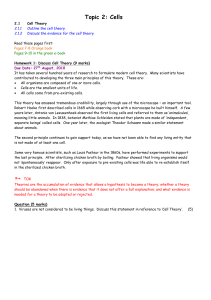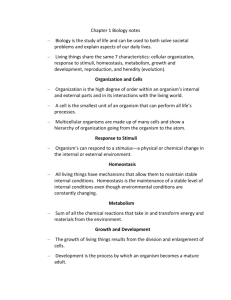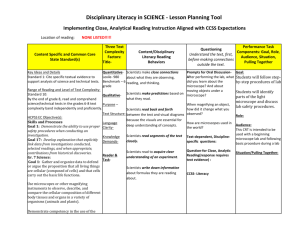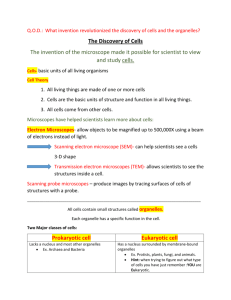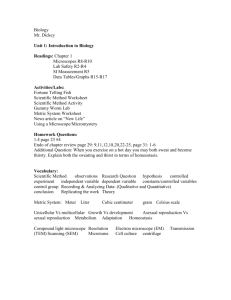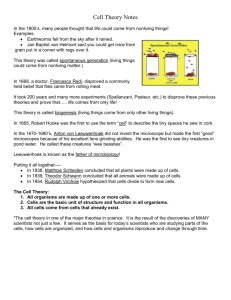Chapter 1 Study Guide
advertisement
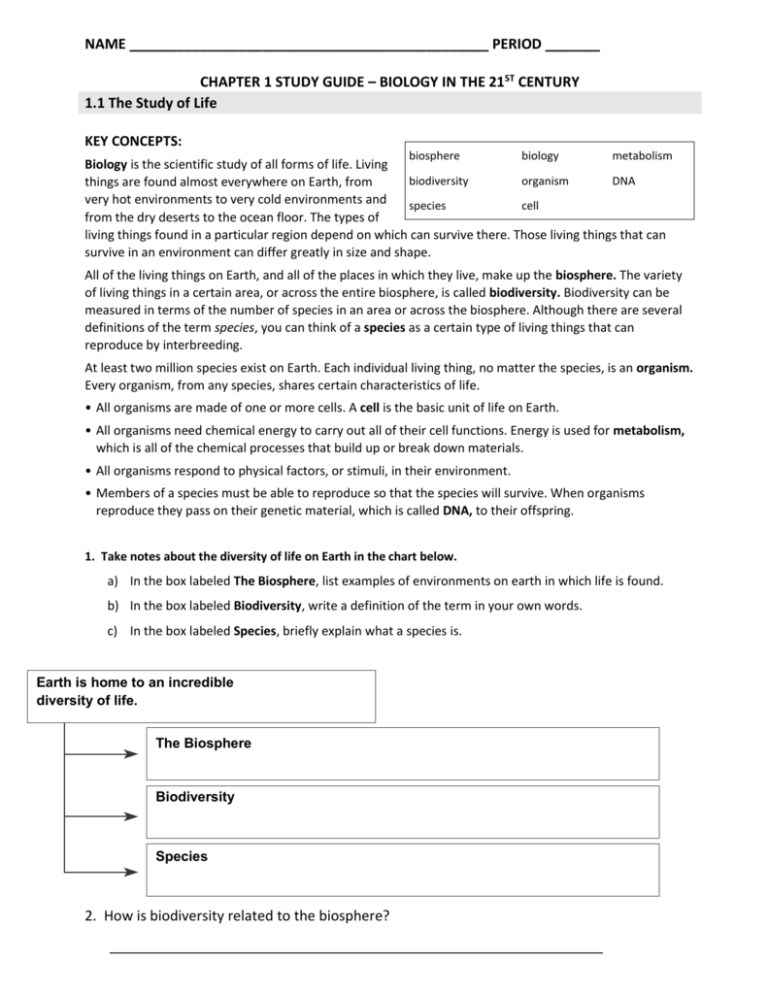
NAME ______________________________________________ PERIOD _______ CHAPTER 1 STUDY GUIDE – BIOLOGY IN THE 21ST CENTURY 1.1 The Study of Life KEY CONCEPTS: biosphere biology metabolism Biology is the scientific study of all forms of life. Living biodiversity organism DNA things are found almost everywhere on Earth, from very hot environments to very cold environments and species cell from the dry deserts to the ocean floor. The types of living things found in a particular region depend on which can survive there. Those living things that can survive in an environment can differ greatly in size and shape. All of the living things on Earth, and all of the places in which they live, make up the biosphere. The variety of living things in a certain area, or across the entire biosphere, is called biodiversity. Biodiversity can be measured in terms of the number of species in an area or across the biosphere. Although there are several definitions of the term species, you can think of a species as a certain type of living things that can reproduce by interbreeding. At least two million species exist on Earth. Each individual living thing, no matter the species, is an organism. Every organism, from any species, shares certain characteristics of life. • All organisms are made of one or more cells. A cell is the basic unit of life on Earth. • All organisms need chemical energy to carry out all of their cell functions. Energy is used for metabolism, which is all of the chemical processes that build up or break down materials. • All organisms respond to physical factors, or stimuli, in their environment. • Members of a species must be able to reproduce so that the species will survive. When organisms reproduce they pass on their genetic material, which is called DNA, to their offspring. 1. Take notes about the diversity of life on Earth in the chart below. a) In the box labeled The Biosphere, list examples of environments on earth in which life is found. b) In the box labeled Biodiversity, write a definition of the term in your own words. c) In the box labeled Species, briefly explain what a species is. Earth is home to an incredible diversity of life. The Biosphere Biodiversity Species 2. How is biodiversity related to the biosphere? _______________________________________________________________ 3. Where do all living things on Earth exist? _______________________________________________________________ 4.What is one way in which biodiversity can be measured? _______________________________________________________________ _______________________________________________________________ 5.List the four characteristics of living things. _______________________________________________________________ _______________________________________________________________ 6. Summarize each of the characteristics of living things in the table below. Characteristic Summary Sentence Cells Energy and metabolism Response to environment Reproduction and development 7. What is metabolism? _______________________________________________________________ _______________________________________________________________ 1.2 Unifying Themes of Biology KEY CONCEPTS: Several major concepts run through all of biology. These underlying ideas, or unifying themes, demonstrate the relationships among all organisms and help to connect one field of biology to others. system homeostasis ecosystem evolution adaptation • Systems: A system is a group of related parts that interact to form a whole. Groups of molecules can interact to form the cellular machinery for a particular process. Groups of cells can interact to form an organ, such as the heart. Groups of organisms can interact within an ecosystem. An ecosystem is a certain area in which living and nonliving things interact. • Structure and Function: The biological function of a part of an organism is directly related to that part’s structure. This relationship is found in molecules within cells, among different types of cells, and across different species. Different organisms have different specialized structures that perform functions specialized to that species. • Homeostasis: All organisms must keep their internal conditions stable in order to stay alive. Homeostasis is the maintenance of these conditions. Homeostasis is necessary because the cells of all organisms function best within a particular range of conditions. If conditions vary too far from the ideal set, cells will not be able to function normally. When internal conditions change, a negative feedback system often acts to return the condition to normal. • Evolution: Evolution is the process by which the genetic makeup of a population changes over time. One way in which evolution occurs is through the natural selection of genetic traits that give an individual an advantage in a particular environment. Individuals with these advantageous traits, or adaptations, are more likely to survive and reproduce. MAIN IDEA: All levels of life have systems of related parts. 1. What is a system? _________________________________________________________________ _________________________________________________________________ 2. What are some examples of systems? _______________________________________________________________ _______________________________________________________________ Complete the table by writing either the level of life or an example of a system at that level of life. Level Example 3. Chemicals and processes interact in a precise way so that a cell can function properly. Cells 4. 5. Different parts of a living thing work together so that the living thing can survive. Ecosystem 6. MAIN IDEA: Structure and function are related in biology. 7. What are structure and function? _________________________________________________________________ _________________________________________________________________ 8.How does structure affect function in biology? _________________________________________________________________ 9. Give an example of how structure and function are related on the cellular level. _________________________________________________________________ MAIN IDEA: Organisms must maintain homeostasis to survive in diverse environments. 10. What is homeostasis? _________________________________________________________________ 11. Why is homeostasis important to the survival of an organism? _________________________________________________________________ _________________________________________________________________ 12. In the space below, draw a sketch to help you remember what negative feedback is. Body temperature decreases. Body systems send messages. MAIN IDEA: Evolution explains the unity and diversity of life. 12. What is evolution? _________________________________________________________________ 13. Over the course of time, evolution _______________ the genetic makeup of a population. 14. _____________ are genetic traits that give an advantage to an individual and can be passed on to offspring 15. A system in which living and nonliving things in a certain area interact is called a(n) _________________. 16. The maintenance of constant internal conditions in an organism is called ______________. 1.3 Scientific Thinking and Processes KEY CONCEPT Science is a way of thinking, questioning, and gathering evidence. observation hypothesis independent variable constant data experiment dependent variable theory Scientists do not use one scientific method, but all science is based on the same principles: curiosity, critical and logical evaluation of evidence, and the open and honest exchange of data. In any scientific inquiry, scientists • Make observations: Scientists use their senses and various measurement tools to collect information, or make observations, about the world. • Form hypotheses: Scientists propose answers to scientific questions, or form hypotheses, based on observations they, or other scientists, made. • Test hypotheses: Scientists devise methods of observing and experimenting to test their predictions. • Analyze data: Scientists use statistics to analyze data. This analysis tells a scientist whether a hypothesis is supported or not supported by the data. • Evaluate results: Scientists evaluate both their own results and the results from other scientists. Scientists use experiments to test hypotheses. A scientific experiment uses tightly controlled conditions to test a possible cause-and-effect relationship between variables. In an experiment, there are constants and two types of variables: the independent variable and dependent variables. • Independent variables: An independent variable is a condition that is manipulated by a scientist to determine its effect on a dependent variable. An independent variable is the “cause.” • Dependent variables: A dependent variable is measured by a scientist to study the effect of the independent variable. It is the “effect” and depends on the independent variable. • Constants: Factors that are controlled so that they do not change are constants. A hypothesis is a proposed explanation for a single observation. A scientific theory, however, is a proposed explanation for a wide range of observations and experimental results, and is supported by a wide range of evidence. MAIN IDEA: Like all science, biology is a process of inquiry. 1. How do scientists use hypotheses? ____________________________________ _________________________________________________________________ 2. What is the difference between independent variables and dependent variables? _______________________________________________________________ _________________________________________________________________ _________________________________________________________________ 3. What is a theory? _________________________________________________ _________________________________________________________________ 4. How do scientists use statistics when they test a hypothesis? _________________________________________________________________ ______________________________________________________________ 5. Complete the table below by giving a brief description and a brief example of each of the scientific process terms. Scientific Process Description Example Observation 1. 2. Data 3. 4. Hypothesis 5. 6. 6. Why is it important that a scientist’s results are evaluated by other scientists? _________________________________________________________________ _________________________________________________________________ 7. Look at Figure 3.3 on pg. 15. Beginning with observation, what are five parts of scientific thinking? _________________________________________________________________ _________________________________________________________________ MAIN IDEA: Biologists use experiments to test hypotheses. 8. In _______________ studies, scientists do not interfere with what is going on. 9. Scientists can test hypotheses through ____________. 10. A(n) ____________ variable is one which is observed and not manipulated by the scientist. 11. How are constants different from independent variables? _________________________________________________________________ _________________________________________________________________ MAIN IDEA: A theory explains a wide range of observations. 12. What is the difference between a theory and a hypothesis? _________________________________________________________________ _________________________________________________________________ 13. Why are theories never proven? _________________________________________________________________ _________________________________________________________________ 1.4 Biologists’ Tools and Technology KEY CONCEPT Technology continually changes the way biologists work. microscope molecular genetics gene genomics The invention of the microscope in the late 1600s played a major role in the development of biology as a science. Because microscopes could greatly magnify very tiny things, scientists discovered microscopic organisms, or microorganisms, and recognized the cell as the basic unit of life. Light microscopes are still used by many biologists, and they are still based on the same principles. Other types of microscopes, called electron microscopes, are also commonly used today. • Light microscope (LM): Light microscopes use light and glass lenses to magnify objects. Both living and preserved specimens can be observed with light microscopes. These microscopes can clearly magnify specimens about 1500 times. • Scanning electron microscope (SEM): Scanning electron microscopes use electrons to magnify objects. Electrons that bounce off a specimen are detected and interpreted by a computer to form a threedimensional image of the specimen. An SEM cannot be used to study a living specimen, but it can clearly magnify a specimen more than 100,000 times. • Transmission electron microscope (TEM): Transmission electron microscopes are similar to SEMs. They use electrons to magnify specimens, they cannot be used to study living specimens, and they can clearly magnify specimens more than 100,000 times. Unlike SEMs, TEMs use electrons that pass through a specimen. The images are two-dimensional. Other computer-based technologies are very important in many areas of biology. Computer models are used to study things that would otherwise be impossible to study directly, such as the possible effects of medicines and the potential spread of diseases. Computers are used in genetics research. They can be used to study a single gene, which is a stretch of DNA that stores genetic information, or they can be used to study an organism’s genome, which is all of its DNA. 1. What are the differences between light microscopes and electron microscopes? _________________________________________________________________ _________________________________________________________________ _________________________________________________________________ 2. When are computer models most useful? _________________________________________________________________ 3. What is a gene? What is a genome? _________________________________________________________________ _________________________________________________________________ Compare and contrast the different types of microscopes. Type of Technology Characteristics Light microscope (LM) 1. Scanning electron microscope (SEM) 2. Transmission electron microscope (TEM) 3. Using page R8 (in back of your text) Label the following microscope diagram: What type of microscope is this? _______________________________
